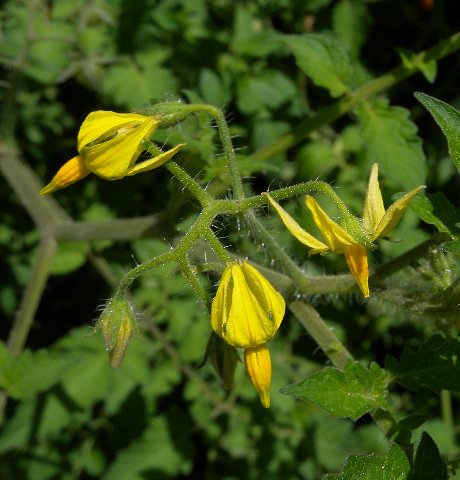
The lateral leaflets are 1¼-3" long and about one-half as much across; they are ovate or lanceolate in shape, coarsely dentate or crenate along their margins, and sometimes shallowly cleft. The terminal leaflet is slightly larger in size than the lateral leaflets, otherwise it is similar in appearance. The secondary leaflets are up to ½" long and at least one-half as much across; they are ovate or oval in shape, while their margins are sparingly dentate, crenate, or entire (smooth). The bases of lateral leaflets are often oblique (asymmetric). The upper leaflet surfaces are medium green and sparsely glandular short-pubescent (appearing almost glabrous), while the lower leaflet surfaces are pale green and moderately glandular short-pubescent. The rachises and petioles of these compound leaves are light green and glandular short-pubescent. In addition, they may have scattered spreading hairs. The petiolules (basal stalklets) of the lateral and terminal leaflets are up to ¾" long, light green, and glandular short-pubescent. The secondary leaflets are sessile, or they have even shorter basal stalklets. Occasionally, short racemes of 3-15 flowers up to 4" long develop from the axils of the compound leaves. Each flower is about ½" across, consisting of a short calyx with 5 linear teeth, a yellow corolla with 5 spreading to strongly recurved lobes, a column of 5 united stamens, and a pistil with a single style. The calyx is light green and glandular short-pubescent; it may have a few spreading hairs. The lobes of the corolla are narrowly deltate (triangular) and they are longer than the teeth of the calyx. The peduncle and pedicels of the raceme are light green, glandular short-pubescent, and often crooked; they also may have scattered spreading hairs.
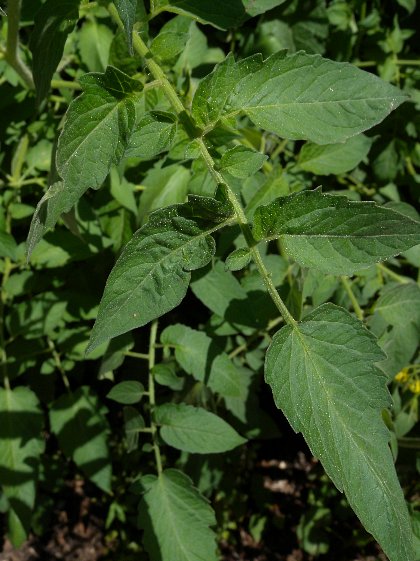
The blooming period occurs from early summer into autumn, lasting several months (for indeterminate seed-started plants). Some flowers will fail to set fruits; they are self-fertile to some extent, but fruit-set is better with either hand- or insect-pollination. The fruits are berries ranging from ½" to 4" across; wild plants usually produce smaller fruits. These fruits are subgloboid, globoid, broadly ellipsoid, or pyriform (pear-like) in shape with shiny smooth skin; young fruits are glandular short-pubescent, but they become more glabrous with age. Immature fruits are light green or whitish green, but they become yellow, orange, or red (usually the latter) at maturity. The peduncles, pedicels, and calyx teeth of these fruits become enlarged as they mature. The interior of mature fruits is fleshy, juicy, and slightly tart-sweet; numerous seed-bearing cavities are scattered throughout the interior (although smaller fruits will have fewer seed-bearing cavities). Individual seeds are 2.0-3.5 mm. long and about one-half as much across; they are light tan, flattened-obovoid in shape, smooth-sided, and finely pubescent along their margins. The light seeds are sometimes distributed by wind or water. This plant reproduces by reseeding itself.
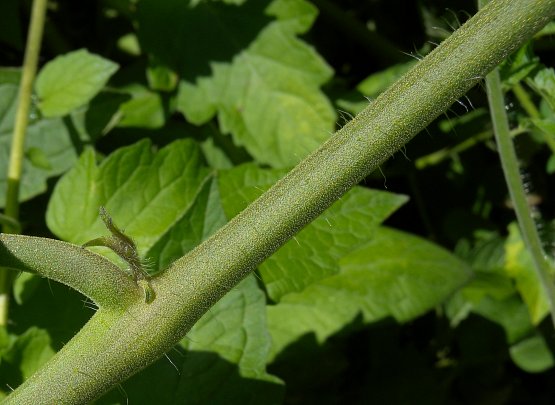
Cultivation: The preference is full sun, moist to mesic conditions, and fertile loamy soil. Partial sun and less fertile soil is tolerated, but fruit set will be smaller. Tomato plants are vulnerable to a variety of disease organisms; different cultivars vary in their disease resistance. Cultivars also vary significantly in the size of plants and the size of fruits that they produce, which can affect the characteristics of escaped plants.
Range & Habitat: As a naturalized plant that has escaped cultivation, the Tomato is scattered across Illinois and it is relatively uncommon (see Distribution Map). Such wild plants rarely persist for more than 1-2 years. The Tomato was introduced into North America from South America. It is widely cultivated for its edible fruits both commercially and in gardens of residential areas. Naturalized habitats include fallow fields, areas around gardens, banks of creeks and drainage canals, gravel and mud bars in streams, roadsides, areas along railroads, and waste places. Disturbed areas are preferred. This cultivated plant is not invasive.
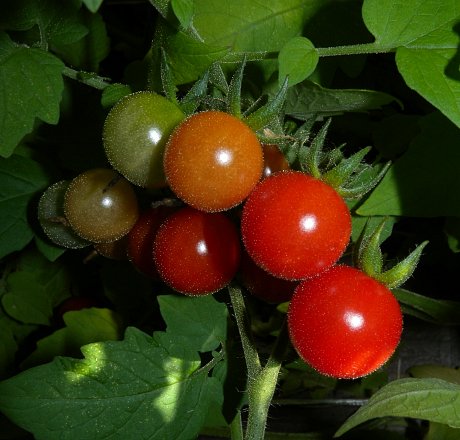
Faunal Associations: The flowers are cross-pollinated by bumblebees, Halictid bees, and possibly other bees. The floral reward is pollen. Insects that feed destructively on tomato plants include several species of leaf beetles (including Epitrix spp., Lema spp., Leptinotarsa decemlineata, Plagiometriona clavata, & Psylliodes affinis), polyphagous stink bugs (including Euschistus spp.), an aphid (Rhopalosiphoninus solani), the Garden Fleahopper (Halticus bractatus), caterpillars of a Noctuid moth, the Tomato Fruitworm (Helicoverpa zea), and caterpillars of two sphinx moths, the Tobacco Hornworm (Manduca sexta) and Tomato Hornworm (Manduca quinquemaculata). Various mammals probably feed on the fruits, but these records are incomplete. The Cottontail Rabbit sometimes nibbles on the foliage of young plants when they are less toxic, and during hot dry summer weather they sometimes gnaw on ripened fruits to gain access to their moisture. There is also some evidence that the Snapping Turtle (Cheldyra serpentina), Eastern Box Turtle (Terrapene carolina), and Ornate Box Turtle (Terrapene ornata) like to feed on the ripened fruits (Ernst et al., 1994; Lagler, 1943). Similar to other berry-producing species in the Nightshade family, tomato seeds can probably pass through the gullets of such animals and remain viable. As a result, these animals may spread the seeds of this plant to new areas. The foliage and immature green fruits are more or less toxic from the alkaloids solanine and tomatine. Thus their consumption is usually avoided by most vertebrate animals.
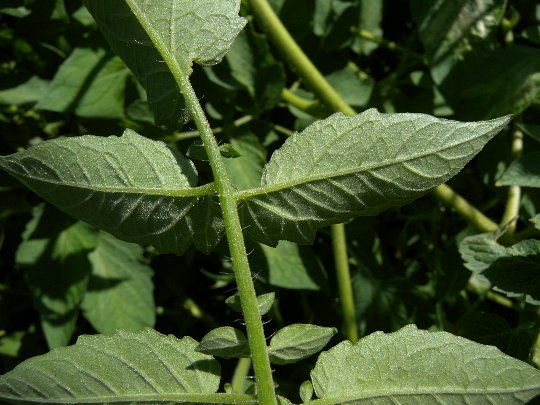
Photographic Location: Along an alley in Urbana, Illinois.
Comments: Because we consume the edible berries of the Tomato, they should be considered a fruit, rather than a vegetable, as the latter term typically refers to the edible leaves, stalks, or roots of various plants. Tomato fruits are widely consumed throughout the world and they are used in a variety of culinary dishes, including salads, stews, and sauces. The fruits contain such beneficial substances as beta-carotene (the precursor to Vitamin A), Vitamin C, potassium, and the anti-oxidant lycopene. It is relatively easy to identify naturalized plants in the wild, especially when they are in the fruit-bearing stage. Because of the glandular pubescence on the foliage and young fruits, tomato plants have a distinctive aroma.